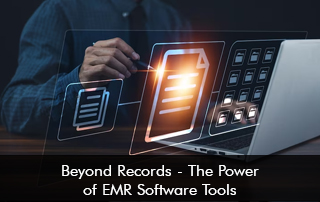Patient care meets cutting-edge technology in Electronic Medical Record (EMR) software and it’s not just medical records. Let’s explore the myriad dimensions of EMR software and how it is an indispensable asset for healthcare professionals.
From Medical Records to Strategic Insights
EMR software tools have transcended the mere digitization of patient records; they have become dynamic repositories of strategic insights. By leveraging advanced analytics, healthcare providers can extract invaluable information from patient data. Trends, patterns, and correlations within the data can be identified, paving the way for informed decision-making. This shift from passive record-keeping to active data analysis empowers healthcare professionals. It allows them to anticipate patient needs, identify high-risk populations, and tailor treatment plans for better outcomes.
EMR Software Enhancing Patient-Centric Care
At the core of EMR software’s evolution is a renewed focus on patient-centric care. It facilitates a holistic approach to patient management by providing a comprehensive view of a patient’s history, treatments, and outcomes. EMR software enables healthcare providers to understand the unique needs and preferences of each patient, fostering personalized and effective care. The ability to access patient records anytime, anywhere ensures continuity of care, enhancing the overall patient experience.
Interconnected Healthcare Ecosystem
The power of EMR software tools extends beyond the confines of individual medical practices. In an era where collaborative care is increasingly essential, these tools create an interconnected healthcare ecosystem. Seamless integration with various healthcare systems, (laboratories, pharmacies, and imaging centers,) ensures that relevant information is accessible to all stakeholders. This interoperability not only streamlines communication but also promotes a more coordinated and efficient healthcare delivery model.
EMR Software Promotes Efficiency in Administrative Processes
EMR software tools are indispensable in optimizing the administrative processes that form the backbone of healthcare practices. From appointment scheduling to billing and claims, these tools automate and streamline tasks that are labor-intensive and prone to errors. The result is improved workflow efficiency, reduced administrative burden on healthcare staff, and, ultimately, more time dedicated to patient care. The automation of repetitive tasks also minimizes the risk of human errors, contributing to a higher standard of accuracy in administrative processes.
Regulatory Compliance and Data Security
EMR software tools provide a robust framework for ensuring compliance and safeguarding patient data. Adhering to regulations such as the Health Insurance Portability and Accountability Act (HIPAA), these tools employ advanced security measures. This includes encryption and access controls, to protect sensitive information. This commitment to data security fortifies patient trust and shields healthcare providers from legal and financial ramifications associated with non-compliance.
EMR Software Telehealth Integration for Modern Healthcare Delivery
EMR software tools play a pivotal role in facilitating its seamless integration. These tools enable telehealth consultations, virtual visits, sharing of medical records, and prescription of medications remotely. The synergy between EMR software and telehealth services not only extends the reach of healthcare but also enhances accessibility. This is especially true for patients in remote or underserved areas.
Continuous Evolution through User Feedback
The power of EMR software tools lies not just in their current capabilities but in their capacity for continuous evolution. Responsive to user feedback and the evolving needs of the healthcare industry, these tools undergo regular updates and enhancements. User-friendly interfaces, improved functionalities, and the integration of emerging technologies ensure that healthcare providers can leverage the latest advancements to deliver better care and enhance their practice management continually.







